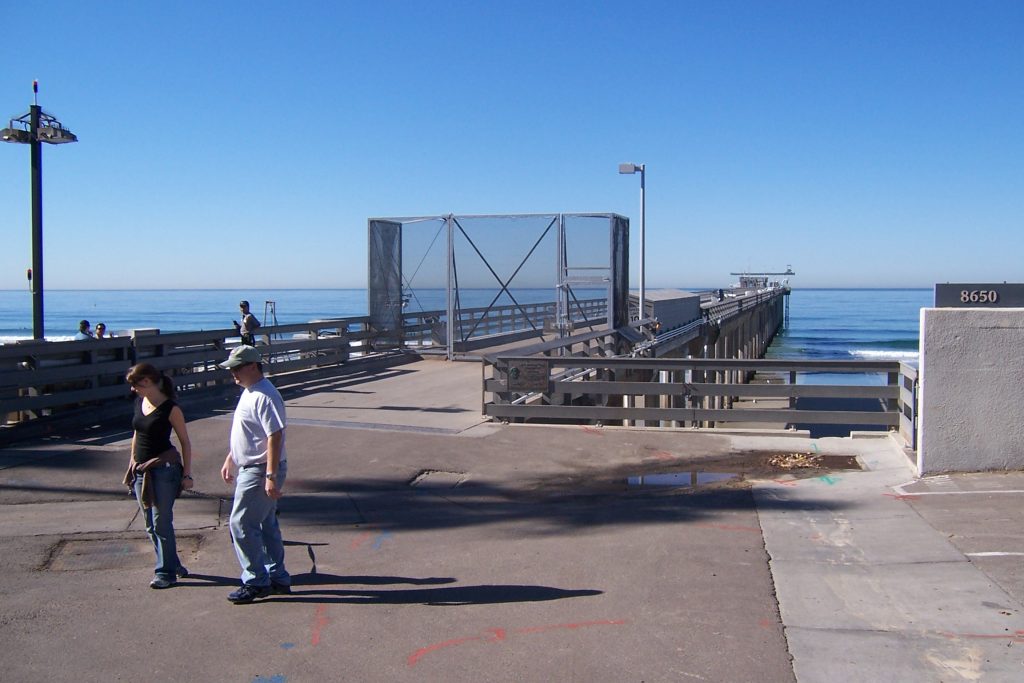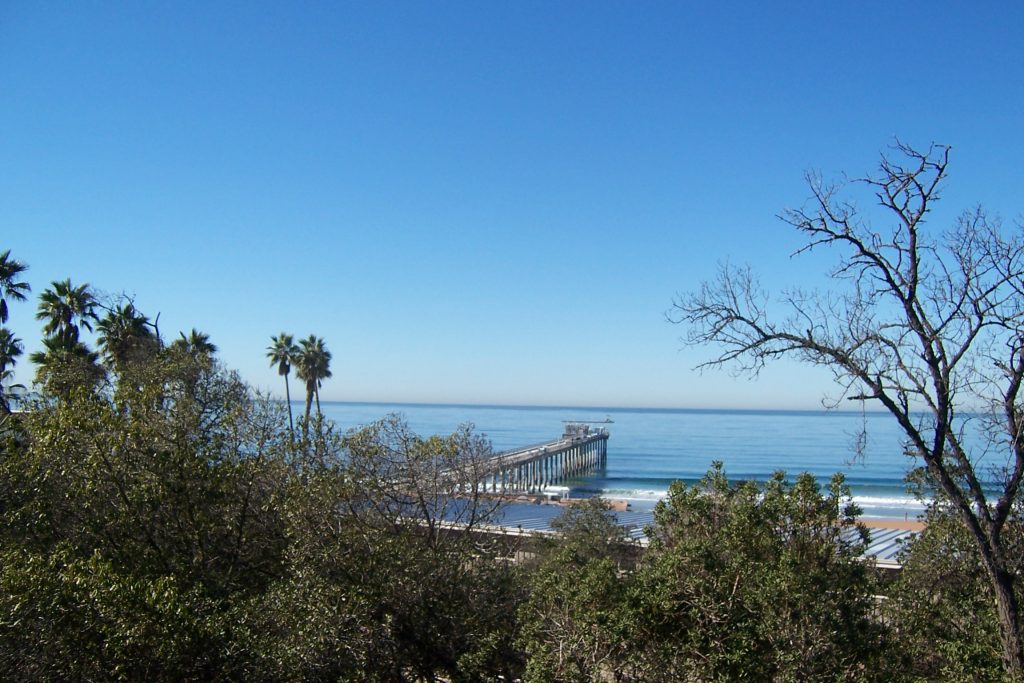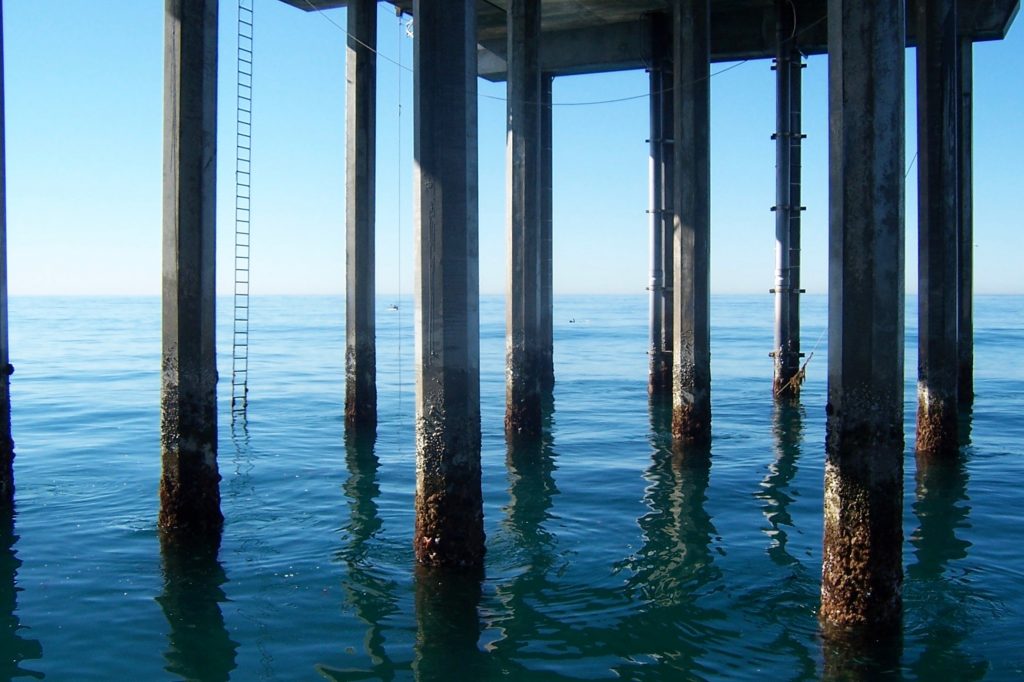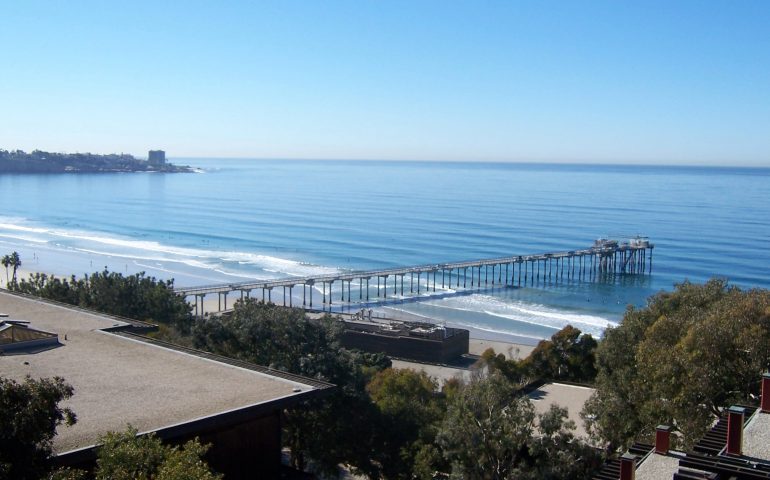Frustration thy name is the Ellen Browning Memorial Pier. One of my long-time goals has been to fish from every California piers (or at least as many as possible) so a visit on 2009 to the pier was both great and frustrating. Hashem, a friend whose daughter worked for Scripps was able to get permission for he. another friend Adam (Baitfish), and I to visit the pier. We walked out to the end and even walked down the steps under the pier to observe the pilings and fish. But as for fishing, NO, it was not to be. An hour’s fishing would have sufficed and catch and release would have been in effect but it just wasn’t allowed (even though I’ve been told an occasional scientist does still wet a line at times).
This fairly famous pier sits just up the coast in La Jolla. That pier is the Ellen Browning Scripps Memorial Pier, known by most locals simply as the Scripps Pier. Fishing, as mentioned, is not allowed although apparently the original pier was open to fishing by the public until 1940.
Nor is the pier generally open to the public to visit (although for a price people can now sign up for “Full Moon Pier Walks” during summer and fall months. It serves as a center for UC San Diego’s Scripps Institution of Oceanography, one of the premier schools of its kind in the world.

The original Scripps Pier was built in 1916 and today the pier has the distinction of having been the daily site for seawater temperature and salinity measurements since August of 1916. It also houses the oldest tide gauge in the open ocean on the West Coast, dating back to 1924.
The original pier, made of concrete pilings and wooden surface, was replaced in 1988 by the new pier that is 1084 feet long and 22.5 feet wide for most of its length (although 46 feet wide at the end where a small lab/pump house is found). The deck on the pier is listed as 33.5 feet above Mean Low Water.
Today, in addition to its role as home base for the school’s various research craft, it contains pumps which intake and pump over 1.8 million gallons of sea water to the various laboratories on campus and the large public aquarium which sit on the hill, high above the pier.
One of the most interesting aspects of the pier is its location itself. Just to the south of the pier lies the west-facing beach known as La Jolla Shores. The beach slopes gently to a depth of about 35 feet and then plummets sharply to a depth of over 2,000 feet in the La Jolla Submarine Canyon. As is usual whenever a pier sits near a submarine canyon, a diverse and interesting mix of fish can show up, especially at night.

<*}}}}}}}}}>< — Fish at the pier:
Mackerel Fishing
In looking over some old pier records today I ran across numerous notations concerning the abundance of mackerel at the Scripps Institution pier in 1919 and 1920. Good catches were also made in 1921, but since that time they have been few and very uncertain at this pier.
1919 was an especially good year. Day after day my pier log indicates that people were making heavy catches. In fact, it was not unusual for individuals to carry away two or three hundred fish of eight to twelve ounces in weight day after day. Some salted down enough to last them all winter, and then gave ample supplies to their kindred and friends.
All of this catching was done by hook and line, and some persons were much dissatisfied if they had to haul up a line with less than four fish on it. Some got so excited that they jerked fish off the hooks and threw them anywhere on the pier floor, in headlong haste to get others hooked. The pier floor was sometimes covered with mackerel mush where the loose fish had been trampled by the hurrying fisherman. Conditions were like this for a month or more in 1919, and many fish were caught over a period of four months up to December.
In 1920 the period of good catches was shorter and there were only scattered days when the mackerel were caught in large numbers. In 1921 there was a marked decrease in the size of the catches and in the number of good days. After 1922 every mackerel fisherman who had got himself spoiled by the heavy catches of 1919 and 1920 has grumbled because there is no good mackerel fishing at the pier any more.
In the last five years probably been less than ten days in which fishermen could make in an hour or two the enormous catches, which were so common in 1919. There is really a difference of some kind.
In response to verbal inquiries at different times I have hazarded guesses at explanation of the change, but, as a matter of fact, no one knows why the one period was so good and the later one so poor. Of course, it is fairly well known that mackerel are erratic in behavior and that they are difficult to study, but that does not really explain anything.
Since I am studying plankton (the microscopic plants and animals on which mackerel sometimes feed) I am naturally inclined to think that the lighter production of plant plankton in the San Diego region in the last several years may have something to do with the condition. Less food for fish, fewer fish. It looks reasonable, but there are lots of angles to the problem.
Further, why is there less plankton? I think this may be possibly be due to less drainage of fertilizing materials from land to sea because of reservoirs and other man-made hindrances in the region; but that is not proven. However, continued study may bring light on this problem as on many another. — W. E. Allen, Biological Feature Service,Catalina Islander, January 4, 1928
Guitar Fish Caught At U.C. Institute
Berkeley, Sept. 2.—Capture of one of the Pacific Ocean’s rarest specimens, the striped guitar-fish was reported by the University of California’s Scripps Institute of Oceanography at La Jolla. The fish, a species of skate, was taken on hook and line by Donald Pigney, son of one of the institute employees off the end of the pier at La Jolla. It was nearly three-feet long, the largest known guitar-fish ever captured. Only two specimens of the fish ever have been taken before, records show. They were less than a foot in length, and were caught about 10 years ago. P.S. Barnhart, curator of the museum at the Oceanography Institute, who reported the catch, made a plaster cast of the fish, and then placed it in preserving fluid. —Oakland Tribune, September 2, 1937

Great White Sharks
<*}}}}}}}}}>< — Most piers in Southern California have, at one time or another, seen great white sharks caught from the pier and, in the past two decades, some have seen so many of the great whites that their capture no longer even merits attention (although today it is illegal and merits a different kind of report).
However, this was not always the case. In fact, there are only a handful of reports of pier-caught great whites in California during the entire 20th century.
The exception was at Scripps Pier where a number were caught in the 1950s. Most were killed but an attempt was made to keep one alive by shipping it north to the large Marineland Oceanarium at Palos Verdes. Unfortunately it too would die shortly after the journey
The first story concerned the hooking of a great white shark from the pier in October of 1955. Apparently two skin divers and an ichthyologist spotted a great white near the pier one day. The next day a specialist in sharks, Arthur O. Flechsig, baited a hook and hooked the fish that eventually was lost. However, the fish supposedly attacked his boat near the pier and left two teeth embedded in the boat—the teeth of a great white. I do not have the newspaper account of that event. However the following reports covers several additional events.
In Great White Sharks by A. Peter Klimley and David G. Ainley, four great whites were reported to have been taken at the “La Jolla Pier” which would have to be this pier. The dates and lengths given were: (1) July 21, 1948, 60 ¾ inches; (2) October 30, 1955, 71 7/64 inches; (3) October 31, 1955, 64 9/64 inches; (4) November 6, 1955, 64 1/64 inches. One more great white is recorded from the “La Jolla Cove” on November 4, 1971. It measured 78 47/64 inches in length. All of these would have been young sharks.
Tiger Sharks Sighted Off La Jolla Shore
La Jolla, Aug. 14 (AP)—Dr. Carl Hubbs, professor of ichthyology at Scripps institution of oceanography here, reported today that tiger sharks, the man eating variety, have been seen in local waters recently. Hubbs said Fred B. Sissler, Scripps bacteriologist, sighted a blunt-headed shark more than five feet long while goggle-fishing near the Scripps pier yesterday. Louis Biller of Phoenix told Scripps scientists that he hooked a five-foot tiger shark while fishing at nearby Pacific Beach two weeks ago [Crystal Pier?]. The tiger shark usually inhabits warmer tropical waters, Hubbs said. —San Bernardino County Sun, August 15, 1950
Man-Eating Shark Is Caught At La Jolla
La Jolla (AP)—A Scripps Institution of Oceanography scientist said Monday a man-eating shark he caught Sunday off the Scripps pier was extremely rare this far north. Arthur O. Flechsig, a research assistant at the institution, said he could recall only three others taken in Southern California waters. The 140-pound great white shark was known to be in the area since two U.S. Naval Electronics laboratory skin divers reported it made a pass at them Saturday. Flechsig was fishing from the pier with a half-inch manila line. He had gone to his home for breakfast when the shark struck at the mackerel bait. It was threshing on the line when Flechsig returned. He killed it with a rifle. —San Bernardino County Sun, November 1, 1955
Rare Sea Haul — Third White Shark Caught
La Jolla (AP)—The third great white shark in two days was caught by Scripps Institution of Oceanography (SIO_ staff members Monday night off Scripps Pier. They caught one Sunday and another Monday afternoon. The three were identified as great white sharks by Dr. Carl L. Hubbs, professor of biology at Scripps. Arthur O. Flechsig, SIO research assistant, and Sam Hinton, SIO museum director, caught the three fish on a 5/5-inch Manila set line. Hinton said only three such sharks are known to have been caught previously off California. The two sharks taken Monday were immature, one a male and one a female, Hubbs said, and the one caught Sunday was an immature female. They ranged from 5 to 6 feet in length… The male shark caught yesterday had in its stomach a two-foot long shark of a different species, a cabezon fish, a quantity of fish line and two hooks that Hinton had lost from a set line Sunday. —San Bernardino County Sun, November 2, 1955
Scientists Get Fourth Shark Off Scripps Pier
La Jolla (AP)—Scientists at the Scripps Institution of Oceanography yesterday captured a 6-foot man-eating shark — the fourth since Sunday — from the Scripps Pier. Art Flechsig, a research assistant, said the shark was taken alive and placed in an outdoor tank on the institution grounds. Flechsig said southern California waters have been practically free of the man-eating or great white sharks… Flechsig said, “We don’t have any idea why they have suddenly appeared here.” Flechsig said the shark would be taken to the Marineland of the Pacific in Palos Verdes. —San Bernardino County Sun, November 4, 1955
Dangerous Baby — Scientists Take Live Great White Shark
La Jolla, Nov. 4 — Scripps Institution of Oceanography scientists went shark fishing again and the result is that Marineland Oceanarium at Palos Verdes today has its first great white shark, a man-killer. Fierce and dangerous though only a baby, the 5-foot, 7-inch, 120-pound male shark was caught on mackerel bait from a line attached to Scripps Pier and hauled through the surf to the beach. Although Scripps scientists had killed three other baby man-eating sharks since last Sunday, they decided to chance taking this one alive. Arthur Flwchsig and Edward Arebalo, staff members, lifted the shark into a tarpaulin and dumped it into an outdoor tank. This afternoon Marineland sent a big tank truck to La Jolla to pick up the vicious creature. Flechsig said that the capture of the four man-eating sharks in one week is an unprecedented occurrence in Southern California waters. The first shark was caught last Saturday after menacing skin divers in an aqualung class at Scripps. A great white shark reaches a length of more than 35 feet and a weight of 10 tons at maturity, Flechsig said. Scientists are mystified at the sudden appearance of the baby sharks here. —Los Angeles Times, November 5, 1955

as i recall sam hinton fid keep one alive long enough to put on display in the aquarium.i also remember sitting on cliffnorth of scripps watching severalmedium sized shark swimming around dike rock a reef of the pier a quarter mile or so. this was at the same time that the sharks were being caught off the pier.
Would loved to have seen that.
This article refers to sharks as “dangerous”, “killer”, “man-eating”, “man-eater”. With the incredible amount of information available today, including research that has been conducted by SIO, it is confounding that you would publish such sensationalized, inane, highly inaccurate misinformation regarding sharks. This only serves to reinforce the age old negative stereotype of sharks which has placed a cloud of fear over the general public and contributed to the extermination of 90% of the global shark population. Please, do your research and better inform yourself on shark behavior, shark-human interaction, and what you can do to HELP, not harm, the protection of sharks who are critical to the health of our marine ecosystems. Yes, the health that supports stocks and populations you depend on for recreational fishing. There are far more recent records of human-shark interactions. Pacific Coast Shark News keeps up-to-date records of reports. This was otherwise would have been an engaging and informative article. Note: I have a marine biology degree from SIO and also worked for CA Fish and Wildlife collecting data regarding marine recreational fishing around San Diego county.
Did you even read the article? What you reference are newspaper headlines for each of the historical stories mentioned. If I am going to report the newspaper stories of the day I have to use their language, I can’t pretend those headlines didn’t exist or make up new headlines.
I know many of the top marine biologists in the state including some often noted as “shark experts,” I have served on several statewide fishery committees (including the MLPA), and have LONG advocated the ethical treatment of all fish, not just sharks (see the Pier Rats Code).
I share many of your views on sharks but am not going to change a quote simply to avoid “words.” If you read the entire article you would see that nowhere do I attack great white sharks in the manner you suggest. I have written literally hundreds of articles and in none have I ever attacked great whites in a derogatory manner and in fact I have often praised those who go out of their way to protect these and other sharks.
You need to do your homework better before attacking someone in such a manner.
Ken Jones
This post does a great job of blending personal experience with historical and scientific insights about the Ellen Browning Scripps Memorial Pier. The frustration of not being able to fish there is understandable, especially considering its rich history of abundant catches. The detailed account of mackerel runs in the early 1900s and the rare catches, like the striped guitarfish and great white sharks, add fascinating layers to the post.
So, the Scripps Pier is mainly for ocean research now; no wonder fishing isn’t allowed anymore, I really didn’t know that!
Reading this article, I gained a deeper understanding of the Scripps Pier; it’s not just a a landmark, but also a testament to the history of marine science.
Good thing I read this article, otherwise I might have foolishly gone to Scripps Pier to fish, only to find out it’s for research!
The pier is not just a scientific installation but also a logistical hub, pumping nearly two million gallons of seawater daily to labs and a public aquarium.
The article mentioning the pier’s fishing history and the large catches from the past is really interesting, making me curious about its history.
If I’m going to this pier in San Diego, after reading this article, I’ll know not to bring my fishing rod, saving myself a wasted trip.